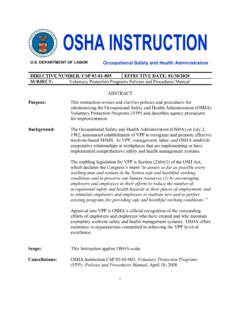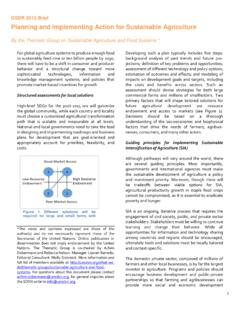Transcription of Implementing an ISMS
1 Implementing AN ISMS 1 Implementing an ISMS Participant Guide Implementing AN ISMS 2 Implementing AN ISMS 3 CONDITION OF USE Queensland Government 2017 All rights reserved. No part of this work may be reproduced or copied in any form or by any means (graphic, electronic or mechanical, including photocopying, recording, taping or information retrieval systems) without the written permission of the Queensland Government Chief Information Office or as otherwise permitted by the operation of the law. Implementing AN ISMS 4 Implementing AN ISMS 5 PURPOSE Critical in today s information centric environment is the subject of information security , whether for reasons of safety, security, legal, ethics or compliance. The management of such information is of paramount importance and an essential element of good organisational practice in today s rapidly evolving world.
2 This is equally important in both the private and public sectors. The international standard ISO/IEC 27001:2013 Information Security Management Systems and its complementary standard ISO/IEC 27002:2013 Codes of Practice for Information Security Management form the basis of the controls necessary to ensure risks to information and systems are understood and effectively managed. ISO/IEC 27001:2013 covers all types of organisations and specifies the requirements for establishing, Implementing , operating, reviewing, maintaining and improving an information security management system in the context of risks presented by the organisation s commercial, technical and regulatory environment. This course provides an opportunity to learn the necessary skills to develop, implement and monitor an Information Security Management System within an organisation and how to assess and protect the organisation against risks.
3 Participants will learn how to evaluate their agency s information risks and implement a practical Information Security Management System (ISMS) that is compliant with the ISO/IEC 27001:2013 standard. Participants will also learn the necessary activities to transition from the existing IS18 framework to an operational ISMS and understand the steps necessary to ensure the ongoing operations of the ISMS The purpose of the course is: To understand the concepts contained within ISO/IEC 27001:2013 and its role in defining and operating an Information Security Management System To develops the skills needed to implement an ISMS based on the ISO/IEC 27001:2013 Information Security Management Systems standard To understand the necessary steps to transition from IS18 to an ISMS Implementing AN ISMS 6 S LEARNING OUTCOMES Upon completion of this course, participants will be able to: Identify the need for information security Understand the drivers for the change from IS18 Understand the contents of an ISMS in the context of ISO/IEC 27001.
4 2013 Define the scope of an ISMS for your agency Identify information security risks Build the appropriate components of an operational ISMS Implementing AN ISMS 7 Module 1: Information Security Implementing AN ISMS 8 S Implementing AN ISMS 9 INFORMATION SECURITY In today s information centric environment, all organisations have a high reliance on the information they own or maintain on behalf of their stakeholders. Risks to this information therefore represent risks to the organisation. Good governance principles suggest that organisations need to have understood their risks and made choices to manage them. The security of this information is critical to the ongoing viability and operations of the organisation. Information has three main characteristics: 1. Confidentiality - Providing access to only those authorised personnel who need the access 2. Integrity - Keeping the information accurate and complete 3.
5 Availability Making sure the information is available to the authorised user when they need it ISO/IEC 27000 defines information security as the preservation of confidentiality, integrity and availability of information . Implementing AN ISMS 10 S Other attributes of information that have a bearing on information security include properties such as authenticity, accountability, non-repudiation and reliability but these are not included within the existing ISO 27000 definition. Information security is important to organisations because the information that is used to deliver services and functions has value. This value is usually related to the consequences to the organisation if the information is compromised in some form. Such compromises include improper disclosure or misuse of the information, accidental or deliberate modification of the information and the unavailability of the information when access to this is required.
6 Consequences from such compromises can include: financial losses; reputational and brand damage; breaches of legal, regulatory or contractual obligations; risks to a person or persons health or safety; inability to deliver organisational services. Such impacts represent risks to the operations and viability of government agencies and private sector organisations alike. Therefore, the identification and management of these risks is vital. Information security management relates to the practices involved in understanding and managing these risks. Please note: For the purposes of this course, when the term ISO 27001 is used, it refers to the ISO/IEC 27001:2013 standard. Similarly, for ISO 27002 read the correct reference as ISO/IEC 27002:2013 Implementing AN ISMS 11 ACTIVITY 1: INFORMATION SECURITY OBJECTIVE To discuss the information security drivers that may exist within agencies and the perceived value of information security with the agency.
7 TIME 15 minutes TASK Brainstorm as a group the following questions. 1. Is information security seen as important within your agency? 2. Why? 3. What drives this? External or internal factors? Implementing AN ISMS 12 S NOTES Implementing AN ISMS 13 Module 2: Background and Context Implementing AN ISMS 14 S Implementing AN ISMS 15 BACKGROUND - IS18 Historically, Queensland Government agencies were required under the QGEA to implement the requirements of IS18 to protect information and ICT assets from unauthorised use, modification, loss or release. The IS18 framework provides a compliance-based approach to achieving the Government s security objectives. IS18 aimed to prescribe a minimum set of controls and activities to create a secure ICT posture. This compliance-centric approach was appropriate whilst the Queensland Government developed a security capability.
8 However, as the capability matured, the use of a compliance-based approach was seen to have a number of limitations in its approach. The current version of IS18: Is not aligned to the current version of the ISO/IEC 27001:2013 information security standard, having been built against the 2005 version of ISO 27002; Needs refreshing to match agency requirements in managing increasing complex ICT and business environments; Focuses on controls, not control objectives; Lacks guidance on governance and assurance requirements; Represents a one size fits all approach to security and may lack flexibility needed in a modern organisation; Implementing AN ISMS 16 S Relies on self-assessment, which provides limited assurance; Is often viewed as a once a year activity; Is not well understood by industry and providers. Consideration of a more flexible approach to management of information security has led to the development of an approach based on ISO 27001.
9 This approach takes into account the following: Compliance to security standards are no longer considered enough to meet increasing threat environment; Information security needs to continually evolve to assist agencies to manage their risk to acceptable levels; Security is a business issue, not an ICT issue, and a cross-functional approach is critical to success. Implementing AN ISMS 17 THE CHANGES The new framework has the following requirements and benefits: Agencies will operate ISMS based on current international standards (ISO/IEC 27001:2013); Agencies will take a risk centric approach to managing security posture; A reduced set of minimum requirements provides increased focus on meeting control objectives; Control objectives are met with a risk based approach; A systematic approach to risk analysis will be central to control decisions; Security functions are completed during business processes throughout the business lifecycle; Better allocation of time and resources to security challenges relevant to specific agencies; Increased industry adoption of ISO/IEC 27001:2013 will assist in aligning requirements and improving transparency when using cloud and managed services.
10 Note that adoption of the ISMS still provides an environment where all requirements of IS18 are met and does not weaken the security posture. Implementing AN ISMS 18 S NOTES Implementing AN ISMS 19 Module 3: IS18 Transition Implementing AN ISMS 20 S Implementing AN ISMS 21 KEY CONSIDERATIONS The transition from IS18 is not designed to weaken the security posture of agencies. The implementation of an ISMS will leverage the work already done in this space by agencies by utilising the control information during the ISMS construction, implementation and operations phases. The key paradigm shift is from a model focussing at a control level to one that considers the objective of the control and the risks being managed. Controls are selected to manage risk and therefore understanding risks and thus the objective of the control set provides a more structured but flexible approach to security management.









